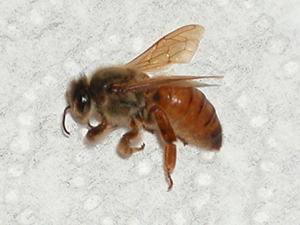 Here is the sad tale of a dead princess, and a queen in waiting, and the beekeeper who vexed them both. Long story short: Twain will have a foreign queen instead of the young virgin they bred up for themselves, and the beekeeper is a little less ignorant at the price of being a little more sad. I have posthumously named the dead virgin queen bee you see here "Joan," after the princess daughter of Eleanor of Aquitaine who died on the way to her wedding.
Here is the sad tale of a dead princess, and a queen in waiting, and the beekeeper who vexed them both. Long story short: Twain will have a foreign queen instead of the young virgin they bred up for themselves, and the beekeeper is a little less ignorant at the price of being a little more sad. I have posthumously named the dead virgin queen bee you see here "Joan," after the princess daughter of Eleanor of Aquitaine who died on the way to her wedding.The story of all this is confused and long. Something was not quite right with the hives starting a couple of weeks ago – or, more accurately, it was NOTICED a couple of weeks ago – and so began the process of requeening the Twain colony, my first time (and poor Queen Eleanor's last, or so I thought).
With new Queen Abigail (after Abigail Adams) and a jar for old Queen Eleanor in hand last Friday, I found that Twain had hatched its own successor instead. In the world of bees, a newborn queen spends a week to ten days running around inside the hives, probably finishing the development of her wings and getting ready for the only extended flight of her life. While she does this, no eggs are laid, and a gap in the brood cycle develops. Right now, the main nectar flow for the year is on, so this gap will be reflected in a poor honey harvest. Also, virgin queens are not much bigger than workers, and are hard to spot, making it hard for the beekeeper to be sure where they are in all this.
Bad beekeeper, BAD beekeeper! Now I had a virgin and a caged queen (and a dowager, who basically no longer mattered), and when I asked for guidance, I was informed that the bees would kill the outsider queen if I released her. (If only I could express to you how downhearted this kind of thing makes me, time after time.) The best advice I got was to take my new queen, make a little nuclear colony for her to live in next door while we waited to see how the virgin would make out. Sometimes they don't come back from their mating flights, sometimes they don't find many drones to mate with. Therefore, it's a good idea to have a backup.
Yesterday, I went to the nuc to release Queen Abigail from her cage, because those bees should have been content to have her now — but she took flight! Oh no! Sometimes this means that the queen knows she will not be accepted, sometimes this means she has been freaked out by a beekeeper placing her in one hive and then another. In any case, she can't really go far, so I tried to find her. Watching every place my foot might fall, I crept around, and found her clinging to the side of a planter. Taking her gently in my hand, I placed my palm over the hole in the inner cover, and she slowly crept in. When I lifted the cover, she had a small circle of attendants. Good sign.
When I checked the Twain colony next door, it looked listless, and I could not find the virgin queen. This bothered me, all night long actually. In a way, therefore, it was no surprise to find poor Joan dead...in front of the nuclear colony, with two worker bees still trying to attend to her. You see, when I made the small colony to house Abigail, Joan must have inadvertently had hitched a ride.
Do you know, in the back of my mind little warnings about this went off, but I had no way to look out for it? In the royal battle that ensued, Joan died. In the world of bees, the main law is this: One queen, at least one, and no more than one. Joan herself actually killed at least one queen pupa after she emerged (yes, friends, I missed TWO capped queen cells). I checked the nuc after finding poor Joan, and Abigail is trucking along inside.
The picture of poor Princess Joan is included here not as morbid proof of the deed, but to help other beekeepers get a look at a virgin queen bee. I could not find a single picture online to help me (excuses, excuses). The hints I would give are this: the abdomen of a queen is almost always paler than the workers' and it comes to more of a point. There is a segmented smooth patch on the back of the thorax just like on a mated queen. Other bees will be very attracted, even to a virgin.
As we stand tonight, with a thunderstorm coming in and no time to make things right until the next time the sun shines, Twain has no queen, and the nuc which had two is back to normal.
So tomorrow, perhaps, I will be reuniting the nuc with the main Twain colony. Eleanor's genes will slowly disappear over the next 5 weeks or so. She was a good queen, and I would have kept her daughter. To heck with the honey harvest.
No comments:
Post a Comment